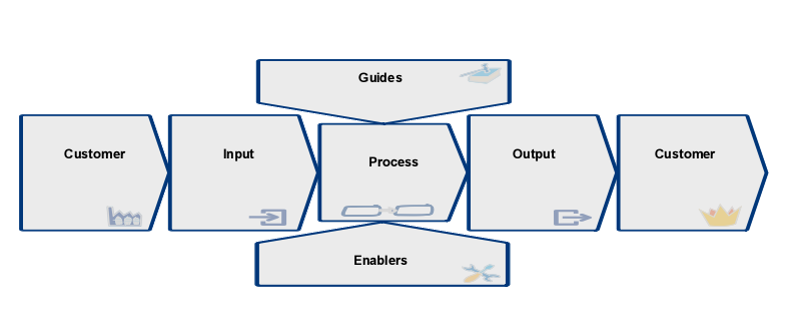A Business Process Model (BPM) is a diagram representing a sequence of activities that describes how a process works, what steps are involved, and how those steps are performed. It typically shows events, actions, and connection points from end to end, focusing on how an enterprise operates and delivers results to external and internal customers.
During Business Process Management training sessions, I’m frequently asked about the best approach to process modeling: How should a process model be created? Where should I start? Should I use a top-down or bottom-up approach? Many of you may have these common questions when beginning to design a process model. In this blog, I’ll guide you through top-down versus bottom-up modeling. First, I’ll clarify some key terms, then share personal experiences along with my preferred method for process modeling.
Before diving into the details of the process model, including work processes and steps, there are several key aspects that the process designer should carefully consider.
First, the designer must define the purpose of the process and identify the target customer. This involves determining the modeling goal by asking: Why are we creating this process model, and who is the customer?
Second, it’s important to define the scope of the process. What are its starting and ending points? The start represents the process input, often referred to as the “start trigger,” while the end signifies the output or result, known as the “end trigger.”
Next, the designer should identify the enablers within the process. Enablers are the actors involved in or supporting the process, such as roles or systems.
Finally, it’s crucial to consider any preconditions that apply to the process, including relevant legislation or internal guidelines. The process model must comply with these conditions to ensure alignment with legal and organizational requirements.

Once the key elements mentioned above have been addressed, the process model can be developed further. There are two primary methods for designing a process model: top-down and bottom-up.
Process designers often favor the top-down approach, which requires a comprehensive, high-level overview of the process. This method is particularly useful in complex organizations, as it helps reduce process complexity. In top-down modeling, we define the work process (step 2 in the figure for top-down modeling) after establishing the start and end triggers (step 1). Once the highest level of the model is defined, we proceed to model the next level down. Each work process is then broken down into process steps, incorporating the associated declarations and data carriers (step 3 in the figure below). This process continues for all other work processes.
ALSO READ: Use a Business Process Maturity Model to measure progress
Next, we identify which process steps need to be further detailed into work instructions. Finally, roles and systems are assigned to each process step. As you can see, the top-down method starts with the work process and progressively breaks it down into more granular details. This approach creates a layered structure within the model, allowing the process designer to organize and manage the process model’s complexity effectively.

The bottom-up method is typically used by process designers who leverage their in-depth knowledge of the subject matter to create a process model. In this approach, the process model is built by first defining each individual process step. Starting with the start trigger (step 1 in the figure for bottom-up modeling), the designer works through each process step until reaching the end trigger (step 2 in the figure below).
Each process step is further developed, including the necessary declarations and storing the relevant data on appropriate data carriers. Once all the process steps between the start and end triggers have been fully developed, a structure is introduced within the model. This structure begins by grouping the process steps, which are then consolidated into work processes at a higher level (step 3 in the figure below).
In this modeling approach, the process is built from the bottom up—beginning with individual process steps and gradually introducing structure by grouping them into work processes at the highest level.

I prefer the bottom-up modeling method. I enjoy starting by determining and developing the content first, then adding structure to the process model. This approach allows me to collaborate with experts who are directly involved in the process steps, ensuring that I capture all relevant details before fitting them into a broader framework of work processes. This method makes translating the content into a cohesive process model easier.
In my experience, the benefits of the bottom-up method are clear. It is easily recognizable for the enablers of the process, ensures that no details are overlooked, and avoids oversimplification. However, I’ve also identified two risks with this approach. First, once the entire process is modeled in detail, the task of structuring everything afterward can be time-consuming. Second, not all details will necessarily add value to the process model.
Some may prefer to work within a predefined framework with clear parameters. Ultimately, the most important thing is that each individual has their preferred approach to modeling a process. There’s no definitive “best” or “worst” method; what matters is the final result—a well-constructed process model.
Through this blog, I aim to raise awareness of the different modeling approaches and encourage you to reflect on your preferred style. I hope this gives you a better understanding of the two process model development methods. Feel free to refer to this blog as a guide when deciding which approach works best for you, and share with me why you chose either method.
David van Eck is a guest blogger and an external Managing Consultant with Enterprise Architecture and Business Process Management expertise.